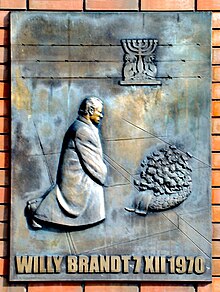You can help expand this article with text translated from the corresponding article in German. Click [show] for important translation instructions.
|
Kniefall von Warschau (lit. 'Warsaw kneeling' or 'Warsaw kneel'), also referred to as Warschauer Kniefall, refers to West German Chancellor Willy Brandt's gesture of genuflection before a memorial to the Warsaw Ghetto Uprising during a state visit to Poland in 1970.[1] Perceived as a sign of profound humility, images of Brandt's action received world-wide attention. More broadly, the gesture came to symbolise Ostpolitik, Brandt's ultimately successful policy of diplomatically reconciling West Germany with its eastern neighbours following the Holocaust and the Second World War.

Event
editThe event took place on December 7, 1970, in Warsaw, Poland, during a visit to a monument to the German occupation-era Warsaw Ghetto Uprising. After laying a wreath, Brandt unexpectedly, and spontaneously, knelt. He remained silently in that position for a short time (about 30 seconds), surrounded by a large group of dignitaries and press photographers.[2] Brandt had actively resisted the early Nazi regime, and had spent most of the time of Hitler's reign in exile. The occasion of Brandt's visit to Poland at the time was the signing of the Treaty of Warsaw between West Germany and Poland, guaranteeing German acceptance of the new borders of Poland. The treaty was one of the Brandt-initiated policy steps (the 'Ostpolitik') to ease tensions between West and East during the Cold War.
Reactions
editThis section needs additional citations for verification. (December 2015) |
In Germany
editOn the same day, Brandt signed the Treaty of Warsaw, which acknowledged the Oder–Neisse line as the final German border with Poland. Both actions attracted controversy within Germany, as did Ostpolitik in general, which was supported by only a narrow majority of the people and had opposition within Brandt's own Social Democratic Party. Its voters had included a significant proportion of expellees from the formerly-German territories in Poland, most of whom left to support the conservative parties.
According to a Der Spiegel survey of the time, 48% of all West Germans thought the Kniefall was excessive, 41% said it was appropriate and 11% had no opinion.[3] Brandt's victory in the next elections, in late 1972, was also due to the growing view among voters that Brandt's Ostpolitik, symbolized by the Kniefall, and his reformist domestic policies were helping to boost Germany's international reputation and so should be supported. His party won its best federal election result ever.
Internationally
editWhile at the time, positive reactions may have been limited, his show of humility was a small but vital step in bridging the gaps World War II had left between Germany and Eastern Europe. In historical terms, Brandt gained much renown for this act. He was named Time Person of the Year in 1970, with the magazine highlighting the Kniefall as one of the main reasons for his recognition,[4] and it is thought to be one of the reasons he received the Nobel Peace Prize in 1971.
A monument to Willy Brandt was unveiled on 6 December 2000, in Willy Brandt Square in Warsaw (near the Warsaw Ghetto Heroes Monument) on the eve of the 30th anniversary of his famous gesture.
Brandt's memories
editBrandt was repeatedly interviewed about the genuflection and about his motives. He later noted that:
- (German original) "Am Abgrund der deutschen Geschichte und unter der Last der Millionen Ermordeten tat ich, was Menschen tun, wenn die Sprache versagt."[5]
- (English translation) At the abyss of German history and under the weight of millions of murdered people, I did what people do when language fails.[6]
Egon Bahr, an eyewitness and Brandt's friend and political ally of many years, recalled in a 2010 interview: "The only thing he said was that at that moment facing the ribbon, he thought: Just laying the wreath is not enough."[7]
Similar act
editDuring a visit to the former Seodaemun Prison in Seoul in August 2015, former Japanese prime minister Yukio Hatoyama knelt in front of a memorial stone as an expression of apology for Japanese war crimes in World War II.[8]
See also
editReferences
edit- ^ "The Nobel Peace Prize 1971". NobelPrize.org. Retrieved 2023-04-22.
- ^ "Willy Brandt-'Warsaw Genuflection' (Eng&Ger Subs)". 100 Years - The Countdown - 1970. YouTube / Zolcer TV / ZDF History. 23 December 2013. Archived from the original on 2021-12-21. Retrieved 20 February 2014.
- ^ "KNIEFALL ANGEMESSEN ODER ÜBERTRIEBEN?". Der Spiegel (in German). 1970-12-13. ISSN 2195-1349. Retrieved 2023-04-22.
- ^ "Man Of The Year: On the Road to a New Reality". Time. January 4, 1971. Retrieved 14 December 2022.
- ^ Kniefall in Warschau Archived 2007-09-27 at the Wayback Machine (German) (from the willy-brandt.org website)
- ^ Unofficial translation of the above lines in a German interview of Brandt
- ^ "Interview: "Plötzlich flüsterte einer: Der kniet!"". Der Tagesspiegel Online (in German). ISSN 1865-2263. Retrieved 2023-04-22.
- ^ Hongo, Jun (13 August 2015). "Former Prime Minister Hatoyama Kneels at Wartime Prison in Seoul". The Wall Street Journal. Archived from the original on 17 August 2015. Retrieved 21 November 2017.
External links
edit- Photo of the Kniefall (photographer: Engelbert Reineke)
- Cover of German news magazine "Der Spiegel" with image of Brandt in front of the monument (photographer: Sven Simon)
- Photo of the Kniefall including wreath, Photographer Hanns Hubmann
- 1970: This photo of a German chancellor went down in history. Why? | History Stories (short documentary on YouTube by Deutsche Welle)